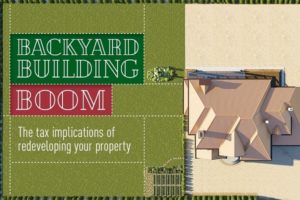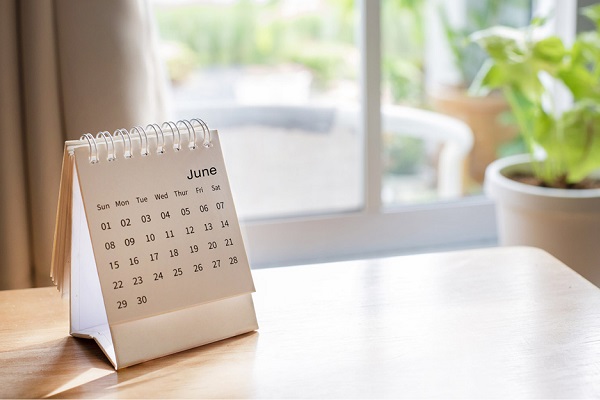With house prices rising and well-located land becoming scarce in cities, many Australians are looking for creative ways to tap into the value of their own backyard. Some subdivide, while others take the knock-down and rebuild route.

But like most things in life, the tax man takes a close interest when it comes to redeveloping your property, so it’s important to get professional advice to ensure you don’t end up with a big tax bill.
If you sell a property bought on or after 20 September 1985, you are liable for capital gains tax (CGT) on any capital gain you make. One bright spot is that you are generally eligible for a full exemption on your CGT liability when you sell your principal place of residence (PPR) if you satisfy the conditions for a main residence exemption.
The tax implications will vary, depending on whether you simply demolish and rebuild; subdivide your property and sell the vacant block; or subdivide, build a new dwelling on the vacant block and then sell it while remaining in your original home.
Demolish and rebuild
If you demolish your home and rebuild, the new property will not be subject to CGT. You must, however, occupy the new residence. Otherwise, the ATO may deem the development was for commercial gain and a subsequent sale will be liable for tax as it is viewed as a new dwelling construction.
You don’t lose your main residence exemption while you are building, as you can elect to treat the vacant land as your PPR from the time the demolished house was last occupied to when you begin living in your new home, provided the gap is not more than four years.
Be aware though that there is a trap when demolishing if you sell your newly vacant land as a development site, or subdivide it into vacant lots. For the PPR exemption to apply, there must be a dwelling on the land. So if you demolish and then sell, the main residence exemption will only apply if the sale occurred when there was a dwelling on the land. Without a dwelling, you can’t claim a partial exemption for the period when there was a PPR on the property.
Subdivide and sell vacant block
A common strategy for homeowners with a large property (under two hectares), is to subdivide. In this situation there is no CGT payable if you retain ownership of both blocks, as you have not made a capital gain or loss.
Subdividing itself does not trigger a CGT liability, but if you later decide to sell the vacant second block, the tax man will want his share of the profit. However, the 50 percent general discount for the CGT liability can be used if you have retained ownership of the block for at least 12 months.
In this situation, the ATO also generally takes the view that selling the second block is not a profit-making undertaking, but rather a ‘mere realisation’ of an asset for income tax purposes. Also, the regulator will not usually consider this type of sale an ‘enterprise’ for GST purposes.
Subdividing, building and selling?
A less common and more complex situation is where you decide to subdivide your property, retain your existing family home, build a new dwelling on the other block and sell it off.
Although this can be profitable, it does come with some challenges. The main challenge being that if you build a new dwelling on the second block and then sell it the PPR exemption for CGT does not apply to that property. The PPR exemption can only be applied to one property (the one you live in), so any capital gain on the second dwelling is liable for CGT, even though it was part of the property originally eligible for the PPR exemption.
To make things worse, if you continue to use your original home as your main residence, the ATO is likely to deem the second dwelling was built with the intention of making a profit, so neither the PPR exemption or the CGT 50 percent general discount can be applied when the second property is sold.
The cost base for the CGT liability is calculated by dividing the original property cost on a ‘reasonable basis’. Building costs and fees for the second dwelling are then added to the split land cost to create the cost base for calculating the capital gain.
GST could also apply to the sale price if you build a new residential premises for sale (even if this is a one-off transaction), although you can generally claim GST credits for your construction costs and any purchases related to the sale.
Case study
Cathy purchased her home in July 2007 for $400,000. In October 2014, she subdivided into two equal blocks, leaving the rear one vacant. Legal fees for the subdivision were $10,000 and Cathy retained ownership of both blocks. When she subdivided, professional valuers allocated equal value to both blocks, so she split the land cost and subdivision fees accordingly.
In February 2016, Cathy sold the rear block for $350,000. The CGT cost base for the rear block was:
| Land cost (50%) | $200,000 |
| Legal fees (50%) | $5,000 |
| Total cost base | $205,000 |
Cathy’s capital gain ($145,000) was the sale price ($350,000) minus the total cost base ($205,000).
The rear block was ineligible for the main residence exemption, but as this type of sale is generally considered asset realisation, Cathy’s $145,000 assessable capital gain could utilise the 50 percent general discount.
The tax rules in this area are complex, so call us to discuss how the tax legislation could affect your property subdivision plans.
Did you enjoy this article?
Click below to share it
More News Articles
Subscribe to Our Mailing List & Connect Through our Socials
While you may have come to us from a variety of sources, the time has never been better to join us.
Subscribe to our mailing list and connect through out socials to keep up to date with our latest news and get some tips.










